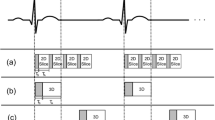Abstract
In order to acquire images of the beating heart, the MR pulse sequence and data acquisition must be synchronised with the patient’s ECG signal. Still imaging uses the ECG signal to trigger the image data acquisition at a single chosen trigger delay after the R-wave. Still imaging is used to image cardiac anatomy, for tissue characterisation or to image the coronary arteries. Cine imaging acquires image data at multiple time points (cardiac phases) throughout the cardiac cycle to produce a sequence of images that can be viewed as a movie. Cine imaging that uses prospective ECG triggering does not image the last part of the cardiac cycle. Retrospective gating allows the pulse sequence to run continuously and the acquired data is assigned retrospectively to the cardiac phases, which enables the whole cardiac cycle to be imaged. Two main types of gradient echo sequence are used for cine imaging, Spoiled gradient echo and balanced Steady State Free Precession (bSSFP). For the spoiled gradient echo technique, the bright blood contrast is highly dependent on speed and direction of flow and flow jets are highly visible. For the bSSFP technique, the Bright Blood contrast depends more on the relaxation properties of blood and is more consistent, but flow jet are less visible. Cine gradient echo imaging is used to image cardiac function, ventricular wall motion and to qualitatively assess blood flow patterns.
Access this chapter
Tax calculation will be finalised at checkout
Purchases are for personal use only
Similar content being viewed by others
Further Reading
McRobbie DW, Moore EA, Graves MJ, Prince MR. MRI from picture to proton. 2nd ed. Cambridge: Cambridge University Press; 2007. p. 282–97. Chapter 14, A heart to heart discussion: cardiac MRI.
Rehwald WG, Wagner A, Albert TSE, Sievers B, Dyke CK, Elliott MD, Grizzard JD, Kim RJ, Judd RM. Clinical cardiovascular magnetic resonance imaging techniques. In: Manning WJ, Pennell DJ, editors. Cardiovascular magnetic resonance. 2nd ed. Philadelphia: Saunders; 2010. p. 19–38.
Ridgway JP. Cardiac magnetic resonance physics for clinicians: part I. J Cardiovasc Magn Reson. 2010;12(1):71. doi:10.1186/1532-429X-12-71.
Author information
Authors and Affiliations
Corresponding author
Editor information
Editors and Affiliations
Rights and permissions
Copyright information
© 2015 Springer International Publishing
About this chapter
Cite this chapter
Ridgway, J.P. (2015). Dealing with Cardiac Motion: How Do We Image the Beating Heart?. In: Plein, S., Greenwood, J., Ridgway, J. (eds) Cardiovascular MR Manual. Springer, Cham. https://doi.org/10.1007/978-3-319-20940-1_13
Download citation
DOI: https://doi.org/10.1007/978-3-319-20940-1_13
Publisher Name: Springer, Cham
Print ISBN: 978-3-319-20939-5
Online ISBN: 978-3-319-20940-1
eBook Packages: MedicineMedicine (R0)



